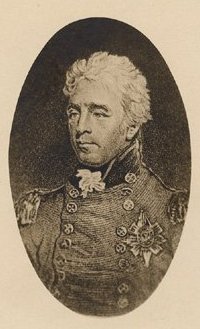Charles Cathcart, 2nd Earl Cathcart facts for kids
Quick facts for kids
The Earl Cathcart
|
|
|---|---|

Lord Cathcart
|
|
| Born | 21 December 1783 Walton, Essex, England |
| Died | 16 July 1859 (aged 75) St Leonards-on-Sea, England |
| Allegiance | |
| Service/ |
|
| Years of service | 1800–1855 |
| Rank | General |
| Commands held | Northern District (1850–55) Commander-in-Chief, North America (1846–47) Commander-in-Chief, Scotland (1837–42) |
| Battles/wars | War of the Fifth Coalition |
| Awards | Knight Grand Cross of the Order of the Bath Order of St. Vladimir, 4th Class (Russia) Knight Fourth Class of the Military William Order (Netherlands) |
General Charles Murray Cathcart, 2nd Earl Cathcart was a very important British Army general. He was born on December 21, 1783, and passed away on July 16, 1859. He was also known as Lord Greenock for many years.
One of his most important roles was serving as the Governor General of the Province of Canada. This was a top leadership position in Canada at the time, from 1845 to 1847. Beyond his military career, he was also very interested in geology. He was even recognized for his discoveries in this field!
Contents
Growing Up: Charles Cathcart's Early Years
Charles Cathcart was born in a place called Walton, in Essex, England. This happened on December 21, 1783. He was the oldest son who survived of William Cathcart. His father later became the 1st Earl Cathcart.
Charles Cathcart's Military Journey
Charles Cathcart began his army career in 1800. He joined the 2nd Regiment of Life Guards as a "cornet." This was a junior officer rank. He worked with Sir James Craig in places like Naples and Sicily.
In 1804, Charles became the next in line to inherit his family's title. This happened after his brother, William, died while serving in the Royal Navy. When his father was made an Earl in 1814, Charles became known by the title Lord Greenock.
Fighting in Important Wars
Charles Cathcart took part in the Walcheren Expedition in 1809. This was a difficult campaign. He also fought at the siege of Flushing. After this, he became ill from a disease that affected many soldiers.
In 1810, he became a lieutenant colonel. He then went to the Peninsular War in Spain and Portugal. He was at the Battle of Barrosa, where he earned a gold medal. He also fought in the Battle of Salamanca and the Battle of Vitoria. During these battles, he worked as an assistant quartermaster-general. This role involved planning troop movements and supplies.
After the Peninsula War
Next, he helped Sir Thomas Graham in Holland. He was in charge of the quartermaster-general's staff. He was present at the Siege of Bergen op Zoom in 1814.
He then fought in the famous Battle of Waterloo. This was a very important battle. During the fight, three horses were shot from under him! For his bravery, he received several awards. These included the Russian Order of St. Vladimir and the Dutch Military William Order. He was also made a Companion of the Order of the Bath (CB). In 1823, he became a lieutenant colonel in the royal staff corps.
Life in Scotland and Canada
In 1830, Charles Cathcart moved to Edinburgh, Scotland. He lived in a place called "Whitehouse villa." He became involved with the Highland Society. He also became a Fellow of the Royal Society of Edinburgh.
While in Scotland, he announced an exciting discovery. He found a new mineral! It was a sulphide of cadmium. This mineral was found during digging for a tunnel near Port Glasgow. Today, this mineral is known as Greenockite.
In 1837, he was made the Commander-in-Chief, Scotland. He also became the Governor of Edinburgh Castle. In 1838, his father passed away. Charles then became the 2nd Earl Cathcart and 11th Baron Cathcart.
In 1846, he was appointed commander-in-chief in British North America. This meant he was in charge of the military there. He also served as the Governor General of the Province of Canada. In 1850, he took command of the Northern and Midland District. He retired from the army in 1855.
Family Life
On September 30, 1818, Charles Cathcart married Henrietta Mather in France. They remarried in England in 1819. Lady Cathcart and their daughters traveled with him to Canada in 1845. Lady Cathcart even presented flags to one of the local militia regiments in Montreal. The family returned to England in May 1847.
Charles Cathcart passed away in St. Leonard's-on-Sea on July 16, 1859. His wife, Henrietta, died several years later in 1872.

